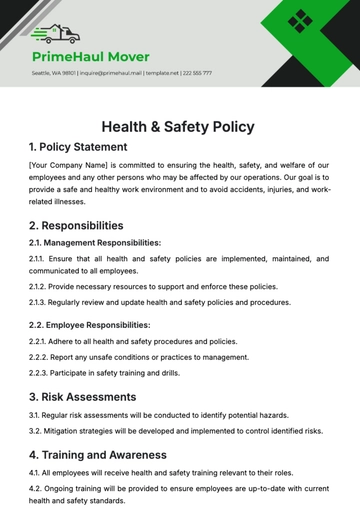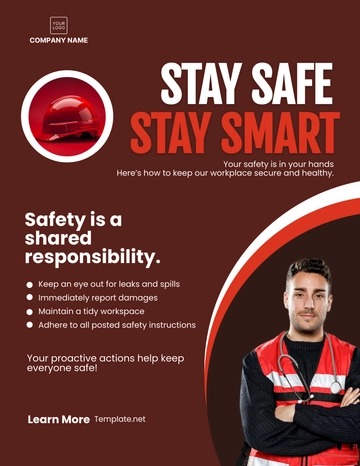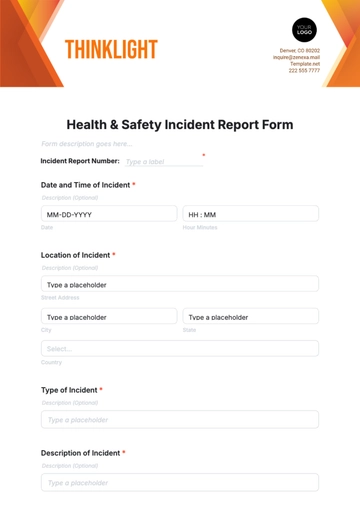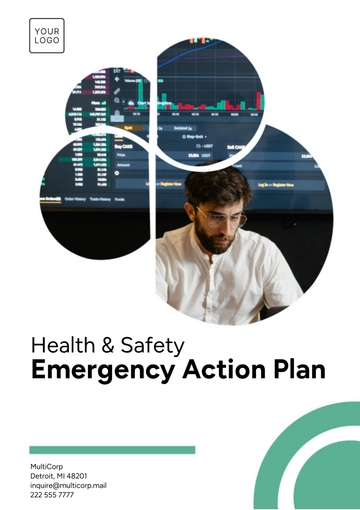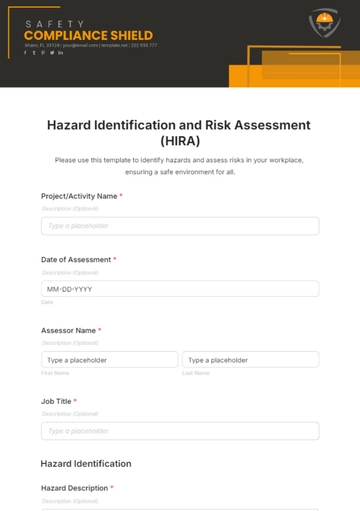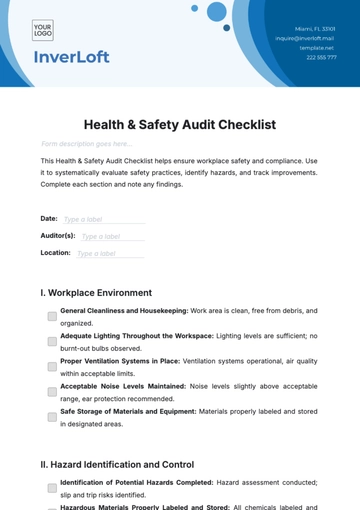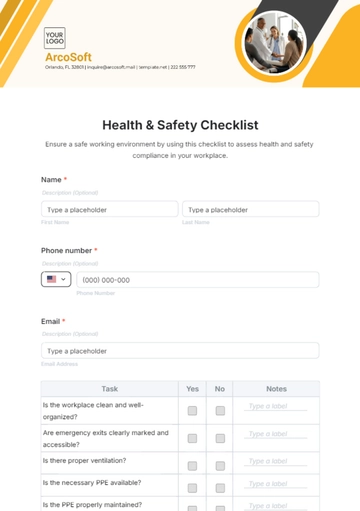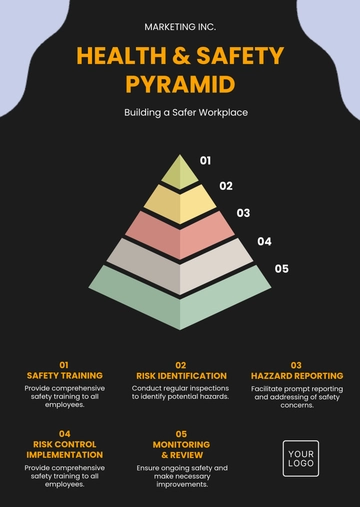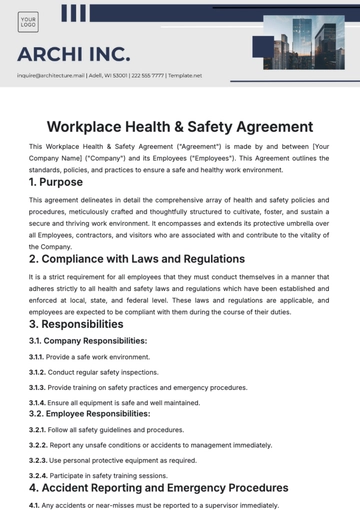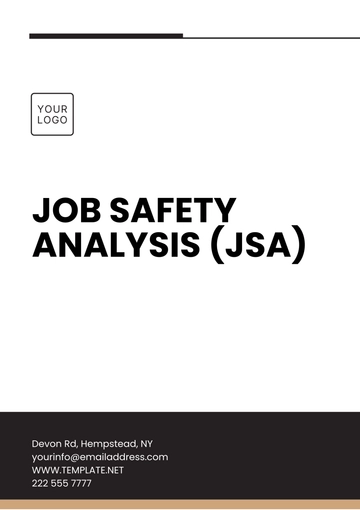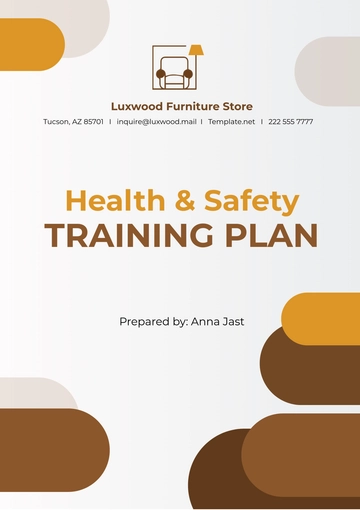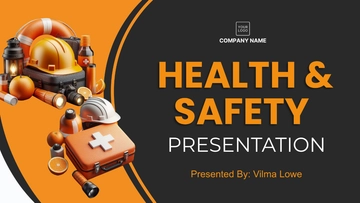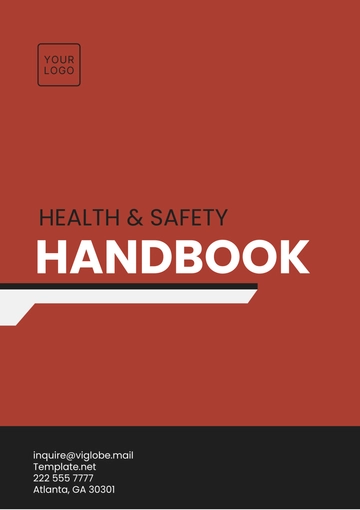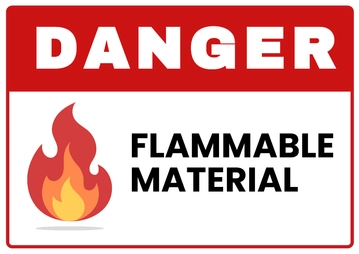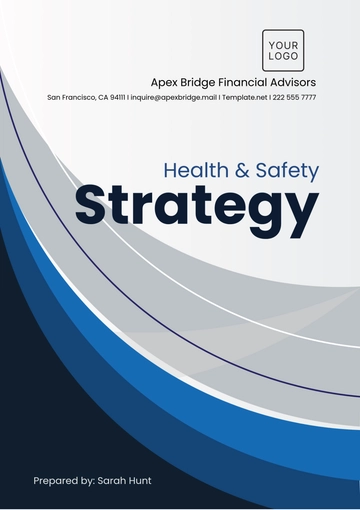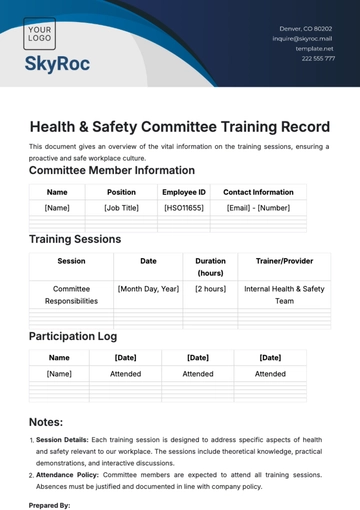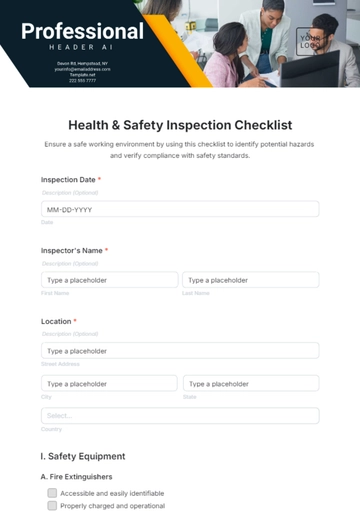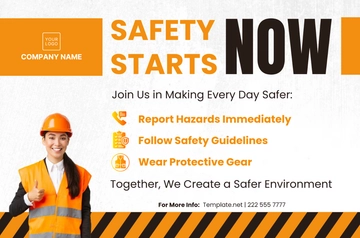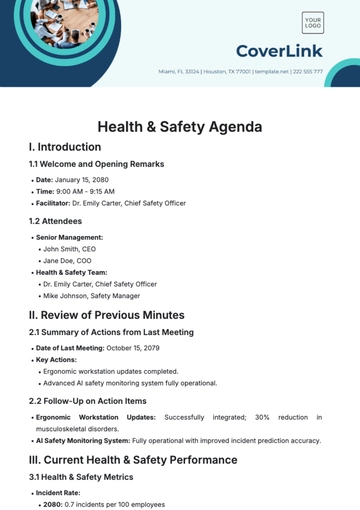Free Health & Safety Awareness Initiatives Case Study
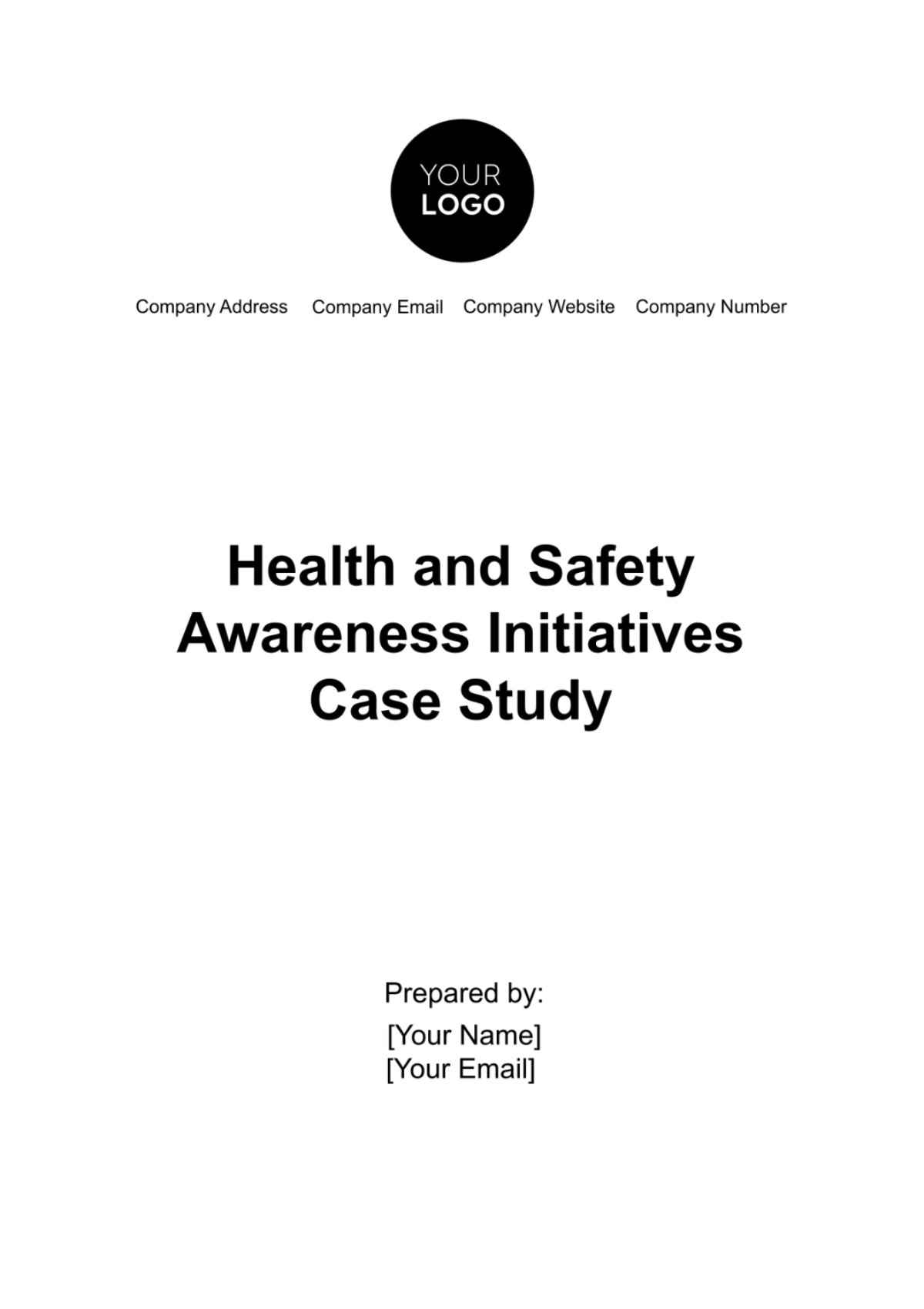
Executive Summary
The Health and Safety Awareness Initiatives at [Your Company Name] have played a pivotal role in enhancing workplace safety, creating a robust culture of employee well-being and regulatory compliance. Over the span of the last [3] years, our unwavering commitment to safety has yielded remarkable results, manifesting in a substantial [25%] reduction in workplace incidents. This reduction not only signifies a tangible improvement in employee health and safety but also underscores the positive impact on overall workforce productivity.
This case study serves as an in-depth exploration of the multifaceted strategies employed by [Your Company Name] to instill and reinforce health and safety practices. It encompasses the meticulous design of training programs, the integration of cutting-edge technological solutions, and the collaborative efforts undertaken to cultivate a workplace environment that prioritizes the physical well-being and security of our employees.
Introduction
In the contemporary landscape, the imperative of prioritizing health and safety in the workplace has become increasingly evident. [Your Company Name], a distinguished entity operating in the dynamic realm of Manufacturing, has been at the forefront of acknowledging and addressing this imperative. In light of industry standards and stringent regulations, our organization recognized the paramount importance of not only complying with these standards but also proactively fostering an environment where employee safety is embedded in the organizational ethos.
The initiation of the Health and Safety Awareness Initiatives represents a strategic and conscientious response to the evolving landscape of occupational well-being. This case study endeavors to unravel the chronicle of our journey in implementing these initiatives. It aims to provide an insightful narrative, delving into the challenges encountered, the strategies devised, and the outstanding outcomes achieved in our quest to create a safer, healthier, and more resilient workplace.
Objectives
The Health and Safety Awareness Initiatives at [Your Company Name] are driven by a set of clear and defined objectives, aligning with the overarching goal of creating a secure and healthy work environment. These objectives include:
Reduction in Incidents: Achieve a further [15%] reduction in workplace incidents by [2050].
Employee Training and Empowerment: Ensure [100%] of employees undergo comprehensive safety training programs annually, empowering them with the knowledge and skills to navigate potential hazards.
Regulatory Compliance: Maintain [100%] compliance with industry safety regulations and standards, continuously adapting to evolving requirements.
Contextualizing the Role of [Your Company Name]
As a trailblazer in Manufacturing, [Your Company Name] holds a pivotal role in shaping the landscape of health and safety practices within the organization. Our role is characterized by:
Leadership Commitment: The leadership team at [Your Company Name] is unwaveringly committed to championing health and safety initiatives, setting the tone for the entire organization.
Employee Involvement: Fostering a culture where every employee is actively involved in promoting safety, contributing ideas, and participating in safety programs.
Investment in Technology: [Your Company Name] leverages state-of-the-art technological solutions, including specific technologies, to monitor and enhance workplace safety.
Continuous Improvement: The organization is dedicated to a culture of continuous improvement, regularly assessing and refining health and safety protocols to stay ahead of emerging risks.
Implementation Strategy
The implementation of Health and Safety Awareness Initiatives at [Your Company Name] involves a comprehensive and systematic strategy. Key elements of our approach include:
Risk Assessment: Conduct a thorough annual risk assessment to identify and prioritize potential hazards, ensuring proactive mitigation measures.
Training Programs: Roll out targeted training programs, covering topics such as Workplace Ergonomics, Chemical Safety, and Emergency Evacuation Procedures, with the goal of reaching [100%] participation among employees.
Safety Protocols: Establish and communicate clear safety protocols, including emergency response plans and incident reporting procedures.
Technology Integration: Leverage cutting-edge technologies, such as IoT-based Safety Monitoring, to monitor and enhance safety measures in real-time.
Training and Education Programs
At [Your Company Name], we believe that a well-trained workforce is fundamental to a safe working environment. Our training and education programs include:
Workplace Safety 101: A foundational training program aimed at introducing employees to safety protocols and hazard awareness, with [250] participants trained annually.
Emergency Response Plan: Ensuring [100%] of employees are well-versed in emergency response procedures through regular drills and training sessions.
Health and Wellness Workshops: Periodic workshops focusing on physical and mental well-being, contributing to a holistic approach to employee health.
Training Module | Number of Participants | Certification Attained |
Workplace Safety 101 | [56] | Safety Awareness Certification |
Emergency Response Plan | [70] | Emergency Response Certification |
Technological Solutions
[Your Company Name] embraces cutting-edge technological solutions to enhance health and safety awareness. The implementation of these technologies includes:
IoT-based Safety Monitoring: We have deployed [500] IoT devices strategically throughout the workplace. These devices continuously monitor environmental conditions, employee movements, and equipment status in real-time. The data collected allows us to proactively identify potential hazards and take preventive measures, contributing to a safer work environment.
Safety Analytics Dashboard: Our organization has implemented a robust safety analytics dashboard that provides real-time insights into incident trends, near misses, and employee compliance. This powerful tool aids in proactive decision-making by presenting key metrics and patterns, allowing us to identify areas for improvement and promptly address emerging safety concerns.
Mobile Safety Apps: [Your Company Name] introduced mobile safety apps designed to empower employees. These apps enable them to report hazards, access safety protocols, and receive real-time alerts. By ensuring constant connectivity to safety information, employees can actively contribute to maintaining a safe workplace and respond swiftly to emerging safety issues.
Virtual Reality (VR) Training: [Your Company Name] has integrated VR technology for immersive safety training. This technology allows employees to simulate hazardous scenarios, providing a realistic and risk-free environment to practice emergency response procedures. The adoption of VR training enhances the effectiveness of our training programs and ensures that employees are well-prepared to respond to real-world situations.
Measuring Success: Key Performance Indicators (KPIs)
The success of Health and Safety Awareness Initiatives at [Your Company Name] is measured through key performance indicators, including:
Incident Reduction: Over the past [3 years], we have achieved a commendable [25%] reduction in workplace incidents. This reduction is a testament to the effectiveness of our health and safety initiatives in creating a safer work environment for our employees.
Employee Feedback: We consistently maintain a high level of employee satisfaction, with a [92%] satisfaction rate in employee feedback surveys regarding safety awareness and training programs. This positive feedback reflects the impact of our initiatives on employee well-being and underscores their engagement in safety practices.
Regulatory Compliance: [Your Company Name] prides itself on maintaining [100%] compliance with industry safety regulations and standards. External regulatory bodies regularly audit our practices, confirming our commitment to upholding the highest safety standards in our operations.
Safety Training Participation: Achieving [100%] participation in mandatory safety training programs among all employees demonstrates the organization's dedication to ensuring that every team member is well-versed in safety protocols and procedures.
Collaboration with [Your Partner Company Name]
Collaboration is integral to the success of Health and Safety Awareness Initiatives at [Your Company Name]. Our partnership with [Your Partner Company Name] has resulted in synergies and shared resources, enhancing safety measures.
Joint Training Programs: Together with [Your Partner Company Name], we conduct [12] joint training programs annually. These programs cover a range of safety topics, from Specific Training Areas to Emergency Response Procedures, ensuring a unified and standardized approach to safety protocols. This collaborative effort guarantees that both organizations benefit from a shared knowledge base, promoting a consistent safety culture.
Shared Resources: Our collaboration extends to pooling resources for safety equipment, training materials, and technological investments. This synergy optimizes efficiency and effectiveness, ensuring that both [Your Company Name] and [Your Partner Company Name] have access to state-of-the-art resources without duplicating efforts. This shared-resource model underscores our commitment to maximizing the impact of our health and safety initiatives.
Mutual Support Mechanisms: We have established a robust system of mutual support with [Your Partner Company Name]. In the event of incidents or emergencies, our organizations collaborate on incident response efforts, sharing best practices and lessons learned. This collaborative approach fosters a culture of collective responsibility for health and safety, benefitting both [Your Company Name] and [Your Partner Company Name].
Employee Feedback and Engagement
At [Your Company Name], the well-being and satisfaction of our employees are paramount. Employee feedback and engagement initiatives include:
Employee Feedback Surveys: We conduct regular employee feedback surveys to gather insights on safety awareness, training programs, and overall satisfaction. With a high participation rate of [80%], these surveys provide valuable input that guides the continuous improvement of our health and safety initiatives.
Recognition Programs: To encourage and acknowledge employees who actively contribute to promoting a safe work environment, we have implemented recognition programs. These programs highlight individuals who demonstrate exemplary commitment to safety, fostering a positive safety culture and motivating others to actively engage in health and safety practices.
Safety Committees: [Your Company Name] has established safety committees with representatives from different departments. These committees serve as forums for ongoing communication, feedback, and collaboration on safety matters. The inclusion of diverse perspectives ensures that health and safety practices are well-integrated across the organization, leading to continuous improvement in our safety initiatives.
Future Steps and Continuous Improvement
The commitment to health and safety at [Your Company Name] extends beyond the current initiatives, as we actively plan for the future and strive for continuous improvement. Our future steps include:
Advanced Technological Integration: Invest in state-of-the-art technologies, such as AI-driven safety analytics and wearable devices, to further enhance real-time safety monitoring and incident response capabilities, ensuring our technological infrastructure remains at the forefront.
Expanded Training Programs: Develop and implement advanced training modules, including specialized courses on emerging risks, to address evolving industry challenges. We aim for a participation rate exceeding [120%], reflecting our dedication to ensuring every employee is well-equipped with the knowledge and skills necessary for a safe workplace.
Collaboration Expansion: Strengthen collaborations with [Your Partner Company Name] and explore new partnerships within the industry to share knowledge, resources, and best practices for mutual improvement in health and safety standards. Our goal is to establish a broader network that contributes to industry-wide safety initiatives.
Employee Well-Being Initiatives: Expand health and wellness programs to address the holistic well-being of employees. This includes rolling out mental health awareness campaigns, introducing fitness programs, and implementing ergonomic improvements across the workplace.
Technology-driven Incident Analysis: Implement advanced analytics tools to conduct in-depth analysis of incidents, near misses, and safety trends. This approach will provide valuable insights for proactive risk mitigation, allowing us to continuously refine and enhance our health and safety protocols.
- 100% Customizable, free editor
- Access 1 Million+ Templates, photo’s & graphics
- Download or share as a template
- Click and replace photos, graphics, text, backgrounds
- Resize, crop, AI write & more
- Access advanced editor
Explore the pinnacle of Health & Safety Awareness Initiatives with Template.net's Case Study Template. Fully editable and customizable using our intuitive AI Editor Tool, this template streamlines the process of showcasing your initiatives. Craft compelling case studies effortlessly, highlighting your dedication to health and safety. Elevate your presentations with Template.net's cutting-edge solutions.

